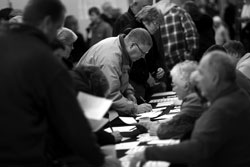Twelve students, including myself, had an experience of a lifetime traveling to and living in the federal capital of Argentina, Buenos Aires.
All participating students took a class taught by Dr. Kenneth Mitchell about Argentine politics and culture. Many students were enticed to take the course and go on the trip not just because of the destination, but because of Dr. Mitchell himself.
As senior Lexi Todd explained, “After taking a Latin American Politics course with Dr. Mitchell I soon became fascinated with the politics and government of these countries as well. This class became the most significant factor in my decision to go. When I found out that Dr. Mitchell was taking a group of students to Argentina I was sold. My deep respect for his knowledge and enthusiasm when studying Latin America soon became contagious.”
Students gained an in-depth view on the country from the class, beginning with the Spanish colonization of the area to the political antics of current president, Cristina Fernandez de Krichner. Learning so much about a country gave the students a whole new perspective, one that would have been impossible to grasp if not for the class. After studying the mechanisms of Argentine culture and then seeing those mechanisms in action, it was like poetry in motion.
Mitchell said he decided to bring students with him because, he wanted to “Show young people how global economics plays out in a different cultural setting, and they will desire to understand inflation (currently 30 percent in Argentina), unemployment, interest rates, and global investment trends. Show young people a fragile, weakly institutionalized democracy, and they will desire to study and value democracy. Show young people a society that eats more red meat daily than any other, yet, on average boasts life expectancy the same as the USA, and students will want to study different societies and their customs.”
Argentina itself is quite unlike any other South American country. Argentines consider themselves European, and Buenos Aires is evidence of that, with its wide boulevards and old world cobble stone streets. The people act like Europeans, giving the proverbial kiss on both cheeks as a greeting, and departing somewhere with a casual “ciao.”
Mark Cosentino said, “Most striking about Buenos Aires was the visible European influence, from the architecture to the pizzas baking alongside the empanadas.”
Buenos Aires is the heart of Argentina, both politically and culturally. The massive city and the suburbs around it hold 33 percent of Argentina’s total population, despite the country being only slightly less the size of India. The group stayed right in the center of the city in the neighborhood of Palermo Soho; an area laced with shops and cafes where one could sit and read for hours, or clubs where you can spend the night dancing on the town.
While the whole experience in Argentina was unforgettable, there were moments that stood out from all the others.
The first moment took place at the Plaza de Honduras while we were welcoming in 2013. At the stroke of midnight, the city of Buenos Aries came alive with jubilation. Fireworks rose up from every direction and the night sky lit up in a collage of spectacular colors. We hugged strangers in the street and cheered with Argentines as we congratulated them and ourselves for making it to the new year.
As junior Cara Turcich reflected on the experience, she said, “New Years in Buenos Aires was unreal. There were fireworks being lit off at every street corner. I loved that it was summer and I got to celebrate with the locals because everyone runs outside and celebrates together.”
The next memorable moment of the trip was with the Asociación Madres de Plaza de Mayo. This was an organization formed during the Dirty War, a time of state sponsored terrorism between 1973-1982 when the Argentine government tortured thousands of civilians, including guerilla militants, trade unionists, left-wing sympathizers, and students. Thirty thousand people went missing during this time, now referred to by Argentines as “Los Desaparecidos.” The mothers of the Los Desaparecidos gathered and marched in front of Presidential Palace every Thursday since 1977.
We met one of the “madres,” an 87-year old woman whose daughter was taken by the government. She told us the story of her daughter, her organization, and their struggle of find out the truth to what happened to their children.
Senior Anthony D’Elia said, “I thought the Madre’s story was heartbreaking, it truly puts into perspective how lucky Americans are to have a stable political system. Ultimately, it was also very empowering, though, to see how those women stood up to a violent dictatorship.” Since the Dirty War, Argentina has come a long way and a new democratic government was established, but still the Madres march to remind people.
Argentina is a beautiful country of great triumphs and tragedies merged to form a strong national character. Buenos Aires is both chic and sobering, a city of that knows how to enjoy itself and to charm on the world stage, but also a city which is haunted by its past and it’s sometimes violate political unsteadiness. Going there and partaking in such a culture was incredibly exhilarating. The fact that we had such thorough knowledge of its background was enriching and added major significance to all of the experiences. Those who attended will undoubtedly remember the trip forever. Any future students lucky enough to go will be going through an experience which will stay with them forever.


